the 2007 Abstract Presentations - Wound Healing Society
the 2007 Abstract Presentations - Wound Healing Society
the 2007 Abstract Presentations - Wound Healing Society
Create successful ePaper yourself
Turn your PDF publications into a flip-book with our unique Google optimized e-Paper software.
<strong>Abstract</strong>s<br />
10<br />
EASY AND OBJECTIVE SKIN COLOR ANALYSIS IN PLASTIC<br />
SURGERY<br />
Aya Yakabe 1,2 , Sadanori Akita 1 , Masaki Fujioka 2 , Akiyoshi Hirano 1<br />
1 Dept. of Plastic Surgery, Nagasaki University,<br />
2 Dept. of Plastic Surgery, Nagasaki Medical Center<br />
Color changes after burn, surgeries such as skin grafting, flap or sclero<strong>the</strong>rapy<br />
for vascular malformations are sometimes concerned. Especially when it is<br />
happened in patients’ exposed areas such as faces and extremities, <strong>the</strong><br />
consequences affect major satisfactions both for patients and physicians.<br />
Easy and reproducible methods are not established yet for objective analysis in<br />
<strong>the</strong>se clinical purposes. Therefore, we tested a hand-held color analyzer (NF-<br />
333, Nippon Denshoku, Co. Ltd, Osaka, Japan), which weighs only 420 grams<br />
for <strong>the</strong> main body and 110 grams for <strong>the</strong> probe, with data transport in Excel<br />
software, for post-treatment skin color change. The parameters contain L, a,<br />
and b, which measures clarity, red color and yellow color. The percent delta of<br />
five-time repeated each parameter to <strong>the</strong> pre-treatment was compared with <strong>the</strong><br />
adjacent area skin color.<br />
Twenty-one patients (14 women and 7 men), average age of 36.6 29.1 years<br />
(1 year to 78 years), with at least 1 year post-treatment (average 2.4 2.2 years)<br />
follow-ups of various procedures such as fibroblast growth factor-2 (FGF-2)<br />
treatment (n = 3), skin grafting alone (n = 7), flap alone (n = 1), flap and<br />
grafting (n = 4), sclero<strong>the</strong>rapy (n = 2), and simple suturing for hypertrophic<br />
scar, embolization and flap, skin grafting with artificial dermis, skin grafting<br />
with artificial dermis and bFGF (n = 1, each).<br />
In comparison with <strong>the</strong> thickness of skin grafting, <strong>the</strong> full thickness grafting is<br />
superior to partial thickness skin grafting in clarity, red and yellow in color in<br />
each pre-operative and surrounding skin (p o 0.01). Similarly, with use of<br />
FGF-2, <strong>the</strong> scars are far softer than those without in second degree burn and<br />
lower calf reconstruction with artificial dermis (p o 0.01) and simultaneously<br />
<strong>the</strong> color changes are more minimal with FGF2 treatment in all parameters<br />
(p o 0.01). For flap surgery and sclero<strong>the</strong>rapy, this analysis would be a<br />
predictive method for post-operative pigmentations or color changes.<br />
12<br />
CORRELATION OF FREQUENCY DOMAIN NEAR INFRARED<br />
(FNIR) ABSORPTION AND SCATTERING COEFFICIENTS<br />
WITH TISSUE NEOVASCULARIZATION AND COLLAGEN<br />
CONCENTRATION IN A DIABETIC RAT WOUND HEALING<br />
MODEL<br />
Michael S. Weingarten, Elisabeth S. Papazoglou, Leonid Zubkov, Linda Zhu,<br />
Michael Neidrauer, Guy Savir, Kim Peace, Kambiz Pourrezaei<br />
Drexel University College of Medicine and School of Bioengineering<br />
Background: This new study evolved from our previous research on fNIR and<br />
wound healing. The purpose of this study was to correlate fNIR with<br />
neovasularization and collagen concentration to quantify <strong>the</strong> wound healing<br />
process.<br />
Methods: Thirty rats were divided into an induced diabetic group (N = 20) and<br />
a control group (N = 10). Full-thickness wounds were made on <strong>the</strong> dorsal<br />
surface and measured twice a week using a frequency domain near infrared<br />
device with four wavelengths of incident light (680, 785, 830 and 950 nm).<br />
Amplitude and phase of scattered light were obtained and tissue absorption and<br />
reduced scattering coefficients were calculated from <strong>the</strong>se data assuming <strong>the</strong><br />
semi-infinite diffusion approximation. These data were <strong>the</strong>n converted to water,<br />
oxygenated and deoxygenated hemoglobin concentrations using error minimization<br />
algorithms. <strong>Wound</strong> dimensions were calculated by image analysis of<br />
cross and parallel polarization pictures. Neovascularization was assessed by<br />
lectin staining and collagen concentration quantified by trichrome staining and<br />
image analysis. Chromophore concentrations were normalized to tissue hydration<br />
by simultaneous measurement of water content.<br />
Results: Oxygenated hemoglobin corrected for tissue hydration increased<br />
monotonically during wound healing in healthy animals and <strong>the</strong>n decreased<br />
with complete wound healing. In diabetic animals <strong>the</strong> increase was not<br />
monotonic and lagged behind <strong>the</strong> controls. Lectin staining revealed increased<br />
neovascularization in <strong>the</strong> healthy animals compared to <strong>the</strong> diabetic ones.<br />
Scattering coefficients correlated with collagen concentration, with lower<br />
scattering corresponding to lower collagen concentration.<br />
Bioengineering/Extracellular Matrix<br />
Session Number: 29<br />
Sunday, April 29, <strong>2007</strong>, 5:00 to 7:00 pm<br />
<strong>Abstract</strong>s 11–19<br />
11<br />
COLLAGEN GEL MATRIX REORGANIZATION BY HUMAN<br />
ADULT AND FETAL DERMAL FIBROBLASTS IS<br />
DIFFERENTIALLY REGULATED BY PROSTAGLANDIN E2<br />
A. Parekh 1,2,3 , V.C. Sandulache 1,2,3,4 , Michael S. Sacks 1,3 , J.E. Dohar 1,2,3,4 ,<br />
P.A. Hebda 1,2,3,4<br />
1 University of Pittsburgh, Pittsburgh, PA,<br />
2 Children’s Hospital of Pittsburgh, Pittsburgh, PA,<br />
3 McGowan Institute for Regenerative Medicine, Pittsburgh, PA,<br />
4 University of Pittsburgh School of Medicine, Pittsburgh, PA<br />
Mechanical loading in newly deposited, collagenous wound tissue causes <strong>the</strong><br />
differentiation of fibroblasts into <strong>the</strong> highly contractile myofibroblast phenotype<br />
in adult wounds; however, this phenotype is not observed in fetal wounds.<br />
The resulting physical remodeling of collagen within <strong>the</strong> wound bed leads to<br />
scarring in <strong>the</strong> adult dermis but regeneration in <strong>the</strong> fetal dermis. Prostaglandin<br />
E2 (PGE2) is an important regulator of tissue repair that inhibits <strong>the</strong><br />
myofibroblast phenotype. This study was designed to investigate <strong>the</strong> effects of<br />
PGE2 on <strong>the</strong> reorganization of anchored collagen gels, an in vitro model of<br />
granulation tissue remodeling, by fetal and adult human dermal fibroblasts.<br />
Small angle light scattering (SALS) is an optical tool used to map <strong>the</strong> gross fiber<br />
orientation of connective tissues with a spatial resolution of approximately 200<br />
microns. SALS was utilized to assess <strong>the</strong> organization of fibroblast-populated<br />
anchored collagen gels after 24 hours of contraction in three distinct areas of<br />
mechanical loading. Differential remodeling was observed in <strong>the</strong> presence of<br />
PGE2. This result was replicated by a PGE2 receptor agonist acting through a<br />
cAMP-dependent mechanism; however, direct upregulation of cAMP caused<br />
decreased matrix remodeling by both fetal and adult fibroblasts. These results<br />
suggest that fetal fibroblasts maintain a remodeling phenotype that can<br />
sufficiently organize a collagen matrix despite <strong>the</strong> lack of myofibroblasts and<br />
adult-like contractile forces, which may have relevance for regenerative wound<br />
healing.<br />
Acknowledgements: Children’s Hospital of Pittsburgh and <strong>the</strong> Pittsburgh<br />
Tissue Engineering Initiative.<br />
13<br />
THE ELR-NEGATIVE CXC CHEMOKINE CXCL11<br />
(IP-9 OR I-TAC) FACILITATES DERMAL AND EPIDERMAL<br />
MATURATION DURING WOUND REPAIR<br />
Cecelia C. Yates, Diana Whaley, Priya Kulasekaran, Joseph Newsome,<br />
Patricia Hebda, Alan Wells<br />
Department of Pathology and Otolaryngology, University of Pittsburgh and<br />
Pittsburgh VAMC<br />
In skin wounds, <strong>the</strong> regeneration of <strong>the</strong> ontogenically distinct mesenchymal and<br />
epi<strong>the</strong>lial compartments must proceed coordinately to restore functionality.<br />
Orchestration of repair is conducted by signals including growth factors,<br />
chemokines, and matrix components. We recently postulated a novel model in<br />
which ELR- negative CXC chemokines (PF4/CXCL4, IP-10/CXCL10, MIG/<br />
CXCL9, and IP9/CXCL11) that bind <strong>the</strong> common CXCR3 receptor limits or<br />
modulates fibroblast and keratinocyte responses to o<strong>the</strong>r signals. The results<br />
obtained in <strong>the</strong> absence of <strong>the</strong> CXCR3 signaling network in vivo during wound<br />
repair revealed a significant delay in dermal healing and <strong>the</strong> re-epi<strong>the</strong>lialization<br />
process. However <strong>the</strong> key communicating protein involved has yet to be<br />
determined as several ELR-negatives CXC chemokines bind to <strong>the</strong> CXCR3<br />
receptor.<br />
We hypo<strong>the</strong>sized that IP-9 produced by <strong>the</strong> redifferentiating keratinocytes<br />
mediates matrix maturation. We generated an antisense to IP-9(IP-9AS) mouse<br />
model. Full and partial thickness excisional wounds were created on both IP-<br />
9AS and WT mice and were histologically analyzed at days 7, 14, 21, 30, and 60.<br />
The wounds in <strong>the</strong> IP-9AS transgenes failed to present detectable IP-9 protein<br />
during <strong>the</strong> wound healing process, in distinction to robust IP-9 production<br />
during <strong>the</strong> regenerative phases of wound healing in wild type mice. <strong>Wound</strong><br />
healing was impaired in <strong>the</strong> IP-9AS mice, with hypercellular and immature<br />
dermis being noted even as late as 60 days after wounding; <strong>the</strong>re was delayed<br />
remodeling of <strong>the</strong> collagen in <strong>the</strong> dermis. Re-epi<strong>the</strong>lialization was delayed by<br />
about 7 days in comparison to <strong>the</strong> wild type mice. Even after epi<strong>the</strong>lial coverage<br />
of <strong>the</strong> wound, <strong>the</strong> delineating basement membrane was ill-constructed. Provisional<br />
matrix components persisted in <strong>the</strong> dermis, and <strong>the</strong> mature basement<br />
membrane components laminin V and collagen IV were severely diminished.<br />
We conclude that IP-9 is <strong>the</strong> key ligand in <strong>the</strong> CXCR3 signaling system that<br />
promotes re-epi<strong>the</strong>lialization, modulate dermal maturation and production of<br />
a mature matrix. These studies were supported by grants from <strong>the</strong> National<br />
Institute of General Medical Science of <strong>the</strong> National Institutes of Health<br />
(USA).<br />
<strong>Wound</strong> Rep Reg (<strong>2007</strong>) 15 A14–A54 c <strong>2007</strong> by <strong>the</strong> <strong>Wound</strong> <strong>Healing</strong> <strong>Society</strong><br />
A17




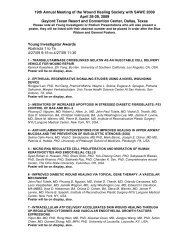

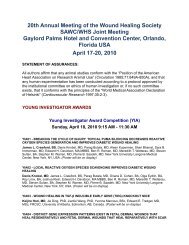
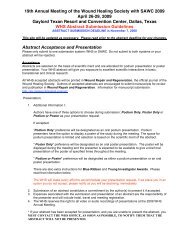
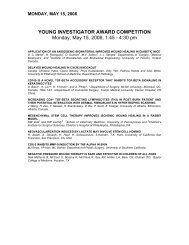



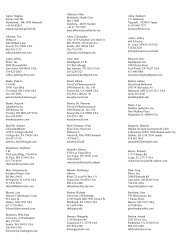
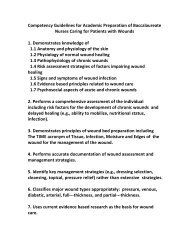
![2010 Abstracts-pah[2] - Wound Healing Society](https://img.yumpu.com/3748463/1/190x245/2010-abstracts-pah2-wound-healing-society.jpg?quality=85)